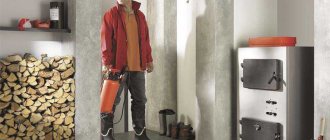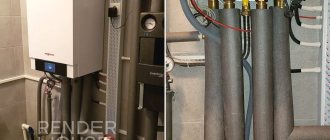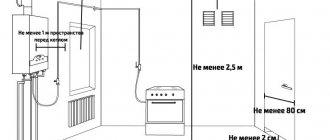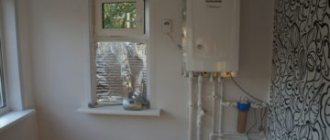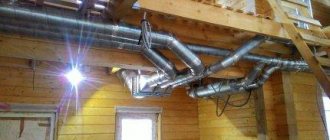Impeccable compliance with standard requirements and practical recommendations during the calculation and construction of a boiler room for a cottage is a guarantee that the heating system in it will work flawlessly, and “living” heat will never leave your home.
Home boiler room: design
The design of modern boiler rooms used in private households may differ. Their features depend on the type of fuel consumed and the type of premises used. According to the method of location, the following types of boiler rooms should be distinguished:
- Built-in. The built-in boiler room is located directly inside the household. The location of the boiler room in a private house is quite convenient, but it is not suitable for every type of heating boiler. Thus, boilers that create a lot of noise (with a forced-air burner) are best used in isolated boiler rooms;
- Attached. They are located in an isolated room located in a special extension to the cottage;
- Freestanding. A separate boiler room for a private house is almost always located in close proximity to the house. It communicates with the main housing through various utilities (heating mains, gas pipelines, water supply and electrical wires).
A separate boiler room for a private home is a universal solution that allows you to install heating boilers of any design indoors, capable of operating on various types of fuel.
In rare cases, a boiler room is installed in the attic of a residential building. But this is the exception rather than the rule.
Alex720517 FORUMHOUSE user
I came to the conclusion that a free-standing boiler room, by all indicators and common sense, is better than a built-in one. Although its construction will cost more. Examples of boiler rooms separate from the house known to me show that heat loss during transfer is minimal (from the boiler room to the wall of the house - 5 meters) when using polypropylene pipes with insulation in a plastic sewer pipe. I’m generally silent about safety. Gas is gas. They don't joke with him. When using a separate facility, there are no boilers, boiler, tank or auxiliary equipment in the house. There is no noise, no unpleasant smell, space is freed up, etc. etc. There seem to be only advantages (except for the rise in price).
Yes, for boiler houses with high power (which can vary from 200 to 500 kW) and a large amount of equipment, it is better to make a separate room. It is convenient, safe and modern. Don't be afraid of the costs associated with building an additional house, as well as possible heat losses. It is worth building a separate boiler room; in this option you will always get more advantages than disadvantages.
If the project is not so cumbersome, then you can limit yourself to an extension to the house or even place the “stoker” in a separate room inside a residential building.
Here's what our user thinks about it.
Car Enthusiast FORUMHOUSE User
It makes sense to use a separate room if there is a large amount of equipment. For small boilers placed on the wall, it is better to install the boiler in the house. By the way, heat losses on the heating main can be quite significant - 20 kWh. On a winter day that’s 3 cubic meters of gas.
Where to place a boiler room in a private house - in the basement of a house, in a garage, in an extension or a special room - is up to you, but you should always plan its space correctly.
How to equip a boiler in private homes, photo.
Where to build a boiler room in a private house is up to you. But if the room could fit all the necessary equipment and there was enough space left for its maintenance, then the layout was done correctly. But we will return to this issue later.
Open and closed heating circuits
Typical boiler room circuits are divided into “open” and “closed”. An open circuit is cheaper to install, but operating costs are significantly higher. In a closed system, the coolant is heated directly in the system, and the pump circulates it.
The main difference between these systems is that in an open system, the coolant in the expansion tank comes into contact with air. This means that some of the heat is lost.
The closed circuit (the most common) is labor-intensive to install, but due to its tightness, heat loss tends to zero.
Boiler room equipment
Uninterrupted operation of the boiler room, and naturally the provision of hot water and heat to the home, is impossible without a whole set of specialized devices and communication components. The necessary components of the system include:
- The boiler is the main heat generator. It is here that the coolant is heated, which is subsequently supplied to a storage electric water heater and radiators. Based on the source of heat energy, boilers are divided into five types: electric, gas, solid fuel, liquid fuel and combined.
- Electric storage water heater – tank-water heater. In the middle of the container there is a tube through which the hot coolant moves - it transfers heat to the water in the electric storage water heater, thus heating it to the desired temperature.
- Distribution manifold - pump, hydraulic distributor and comb. This unit ensures the distribution and uninterrupted circulation of the coolant throughout all elements of the working system.
- Diaphragm tank - expansion tank: compensates for the increase in pressure during the heating of the working coolant.
- Safety devices - Mayevsky valve, safety valves, a device for determining the pressure value: protect the system from excess air and excess pressure.
- Automation – various types of electronic devices that are intended for coordinated control of all elements of the heating and water supply system.
- Flue outlet - exhaust pipe: removes gaseous, liquid and solid substances of working fuel into the environment. There is no urgent need for a smoke exhaust only, for example, if an electric boiler is in operation in the boiler room.
- A set of shut-off valves necessary for timely shutting off the movement of the heat carrier in the event of dangerous situations.
Where to place the boiler room
First of all, you need to remember:
More than two boilers cannot be installed in one room (regardless of its size).
All construction and finishing materials must be fire-resistant and comply with fire standards.
The walls can only be brick or concrete blocks, plastered or tiled. Floor covering - concrete or metal.
Adequate ventilation, especially for gas boiler rooms in the house, and a chimney are required. The air must be renewed at least three times an hour. There must be a window and a door facing the street.
The dimensions of the combustion chamber vary depending on the size of the installed equipment and imply the availability of free space for maintenance.
A complete list of requirements for boiler rooms in a private house in 2018 can be found in SNiP II-35-76.
Finishing materials
When choosing products for boiler room cladding, it is important to ensure sufficient fire resistance, since there is a high probability of ignition. Safety standards and functionality are the main conditions from which it is necessary to build. Be sure to treat all wooden surfaces with a special compound before covering them with any material.
Walls
When considering the question of how to decorate the walls in a boiler room, they take into account the type of base and location of the room. For isolated buildings, you need to select materials that can withstand temperature changes without significant deformation. In addition, resistance to heat and behavior in the event of a possible fire in the room are also important. In the event of a fire, the flames must be contained within the premises for at least an hour.
Tiles in the boiler room Source stroy-podskazka.ru
Traditionally, plasterboard is used for finishing in boiler rooms, but recently several analogues have appeared. For example, acid-fiber sheets, which have a set of unique characteristics, are popular. This material is distinguished by its safety and environmental friendliness, since it does not contain asbestos or harmful compounds. Consequently, when the room is heated, there is no release of toxic substances that affect the health of the owners. Other advantages of the product include excellent strength, resistance to high temperatures and their sudden changes, the ability to bend easily and withstand exposure to liquids.
After fixing the sheets to the surface, they begin the second stage of finishing work - applying a layer of plaster. This substance will provide additional protection against ignition, and also minimize the negative effect of external factors.
To plaster the walls of a boiler room, it is important to purchase special products designed for use in flammable conditions. The substance has a grayish tint, so many owners decide to paint the room after applying it. To give walls any color, ordinary water-based paint is suitable, while the bottom layer will retain its properties and continue to provide reliable protection from flames.
The process of applying plaster Source stroy-podskazka.ru
What you can’t do without in a boiler room
Actually, the boiler itself, in which the coolant is heated. For large houses, you will need to install a collector that distributes coolant between separate groups of heating devices.
An expansion tank (tank), a water heater, a supply pipeline and shut-off valves that regulate the parameters of the heating system are also required.
Don't forget about automation to control the functioning of the system. Of course, the automation unit costs extra money, but these costs will quickly pay off.
Any heating system includes two interconnected systems - a chimney (removes exhaust gases) and ventilation (an influx of fresh air, which increases fuel combustion).
Preliminary processing
The heating system is installed on a flat surface, so first of all you should make it so using one of the following methods:
- For an ideal result, you can choose a wet screed; it allows you to efficiently level any surface. But there is also a disadvantage to using it - the long drying process, which lasts about a month. To correct old screed, it is recommended to use self-leveling mixtures.
Wet screed Source stroy-podskazka.ru
- If you need to carry out work in an accelerated mode, a semi-dry screed, which is a wet material, will help. After application, it needs to be leveled, since the mixture itself does not have this ability.
Semi-dry screed Source stroy-podskazka.ru
- One of the most modern methods is dry screed. It is done using expanded clay, with sheets of plasterboard and plywood laid on top.
Dry type screed Source stroy-podskazka.ru
Gas boiler houses
Increased requirements apply to gas boiler houses (instruction MDS 41-2.2000 and SNiP II-35-76), and gas boilers are subject to mandatory certification.
Remember that obtaining permits will require strict compliance with all regulations and standards. For example, the presence of a gas detector in the room.
Boilers less than 30 kW can be placed in the kitchen provided:
- have good ventilation in case of gas leaks. At the same time, the kitchen window area is at least 0.5 sq.m., and the width of the doorway is from 0.8 sq.m.,
- kitchen walls should be made of fireproof materials,
- The minimum room area is 6 sq.m. with ceilings higher than 2.5 m.
Solid fuel boilers - tips for choosing the best models and ideas for using boilers for heating (110 photos and videos)Screen for a heating radiator - a review of the best ideas and recommendations from designers for selecting screens for a heating system
- Chimneys for gas boilers - main types and step-by-step instructions for do-it-yourself installation (video + 100 photos)
For powerful gas boilers (exceeding 30 kW), you will have to allocate a separate building.
Additional items
The boiler room has a number of important requirements for additional elements. This applies to details such as the chimney, doors and ventilation.
Ventilation
There is no need to install ventilation if an electric boiler is used. This device does not emit any odor or explosive compounds. In other cases, the following rules must be observed:
- can be combined with a house supply ventilation system;
- for a boiler room that will stand separately, ventilation can be realized using louvered grilles, they are made at the bottom of the door, per kW at least 8 cm² of opening;
- change the air three times hourly;
Ventilation option for the boiler room on the ground floor Source avatars.mds.yandex.net
Solid fuel boiler room
According to building codes, there should be no solid fuel boilers in living rooms and kitchens. The extension should be correctly placed next to a blank wall, as shown in the photo of a boiler room in a private house. For high fuel power, independent buildings are built.
Components of an effective solid fuel heating scheme:
- corresponding heat generator,
- boiler piping, including a circulation pump, three-way valve, safety group,
- chimney,
- storage water heater,
- automation unit,
- fire extinguishing complex.
Coal, peat or firewood are solid fuels. In the case of coal, it is important to remember that coal dust in high concentrations is explosive. Therefore, it is important to protect the electrical wiring.
Ventilation system
For proper functioning of gas heating units, a trouble-free air flow is required. It should be enough to both maintain combustion and remove gases.
To ensure good air exchange, a low-power device in a dilapidated building is mainly sufficient for natural ventilation of the room for the combustion chamber. Air enters here from cracks in windows, door openings, and also with the help of other non-densities.
If the boiler installation has sealed door and window openings, then it is hardly possible to do without additional ventilation.
Liquid fuel boiler houses
Installing such a boiler room in a house is much simpler than installing gas or solid fuel analogues. Such furnaces are placed both inside and outside the house.
High noise and specific smell usually exclude the placement of such a furnace in the kitchen. A reasonable solution would be to allocate a separate room with good sound insulation.
Double-circuit gas boiler: the best models, recommendations for choosing and installing a boiler with your own hands (105 photos)What does an inverter air conditioner mean: difference, myths
- Benefits of Drip Irrigation
An absolute plus is that no permits or approvals are required. All that is needed is free access for transport with fuel, as well as regular refueling of the boiler.
General information
Despite the wide range of fuels, the use of solid fuel boilers remains the best option for rural areas, where in most cases there is no gasification.
Of course, you can use electricity, but in this case heating will cost much more. True, many people prefer traditional Russian stoves to boilers. However, this option is only suitable for relatively small houses. If the housing is large and has several floors, then you cannot do without a boiler.
It should be borne in mind that wooden houses are more demanding in terms of fire safety. Therefore, the arrangement of a boiler room requires a special approach and compliance with certain rules, which we will read below.
The walls of the boiler room must be lined with non-combustible material
Summing up
The legislative framework changes frequently, so already at the preliminary stage of designing a combustion chamber it is important to study all current standards and regulations. When planning to install a powerful furnace, it is wise to contact specialized organizations.
Believe me, saving on the work of professionals often leads to a significant overpayment during operation, as well as extremely unpleasant and dangerous consequences for the life and health of your household. Even if the boiler room is small, be sure to consult with specialists.
What is a “smart boiler”
To implement an automation scheme for a private boiler room, you need to invest additional funds. A simple thermostatic valve will cost very little, but programmable systems are many times more expensive.
Constant operation of a conventional boiler in one mode entails a large consumption of electricity and money. Therefore, the cost of purchasing an automation unit quickly pays off during operation.
Automation in a private boiler room guarantees the functioning of the heating system with maximum efficiency, which allows for comfortable conditions for residents living in the house.
By installing automation, the home owner can adjust the heating process according to his needs. Thanks to this, bills for consumed energy resources will be reduced by 2 times.
Controlling the boiler in automatic mode makes it possible to:
- Turn off the boiler in case of an unusual situation. Carry out automatic start or stop of the boiler in the current mode. Depending on the outside temperature, set the heating temperature.
- Manage the heating or water heating branches of a boiler with 1 combustion chamber.
- Regulate the temperature of water or other coolant.
- Make adjustments to the operation of the circulation or recirculation pumps if the heating system in the house is arranged in a closed circuit. In this case, the system cannot function without automation.
The most important element of the heating system is the thermostat. Its function is to regulate the temperature both in a separate room and in the entire house.
There are many types of thermostats - from simple mechanical to weather-compensated. The latter is the most technologically advanced, profitable, but also very expensive.
The heating control system consists of a temperature controller (1), an outside air temperature sensor (2), an actuator (3), a coolant temperature sensor (4), a display for connecting to an external control system (5), a circulation pump (6) , coolant supply (7), consumer circuits (8) (+)
The price of automation depends on the type of boiler used, the presence of heated floors, solar collectors, etc. In order not to spend extra money, you should analyze the features of all schemes and calculate the cost. It is quite difficult to do this yourself, but you can always turn to specialists with this problem.
Photo of boiler rooms in a private house
Little tricks
The decoration of the boiler room can be original and stylish. Brightly colored porcelain tiles combined with designer items and accessories will perfectly fit into the interior of your home. A matte surface interspersed with veins will add volume.
Cleaning will not be difficult. On a light surface, dust is not visible at all.
Doors are installed in two places. One is connected to the house, the second to the street. The entrance is equipped with additional structures. Fire-resistant metal sheet will strengthen the fire barrier. An estimated time of 60 minutes is enough to block the fire and call the fire department.
It is better to take classic, compact, no-frills lamps. Regular lamps will also work. Keep a small flashlight in a visible place in case of a power outage.
Don't get carried away with decoration. After all, the boiler room belongs to the utility rooms. The main boiler here is what you need to think about. Therefore, curb your appetites and direct your creative energy to other objects.
Preparatory work
Installation of equipment requires a level base. Therefore, first of all you will need to level the floor. There are many ways, the choice depends on the design and material of the building, as well as on the desired speed of work:
- A traditional wet screed allows you to get a perfectly flat base, but it dries within 28 days. If the screed has already been poured, it can be leveled with construction self-leveling compounds.
To level the walls, use plaster, plasterboard or CSP boards.
How to paint the floor on the veranda at the dacha with your own hands
Painting your porch is an excellent option for protecting your flooring. Paint protects the floor from damage and corrosion. Various materials can be painted:
- wood - boards, MDF, decking boards;
- concrete.
How to paint the floor on the veranda at the dacha, except with acrylic paint
For painting the wooden floor of an open veranda, the most optimal are acrylic, alkyd, nitro-enamel and oil paints. For good wood, you can also use stain or varnish. Before painting the veranda boards, the floor must be cleaned of remnants of the previous paint, if any, and sanded.
It is better to paint concrete floors with epoxy, acrylic paint or polyurethane enamel. Epoxy paint is not exactly painted on - it is rather “rolled” across the floor with a special spatula until an even layer is formed. It does not wear off over time and gives a very bright color.
How to paint the floor on the veranda at the dacha? Choose acrylic paint and polyurethane enamel. They are applied with a regular brush or roller. Before painting, it is better to clean the surface from dust and prime it, which will ensure better adhesion of the paint.




